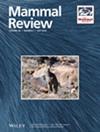奇瓦瓦沙漠陆生哺乳动物的生态相互作用:系统地图
IF 4.4
2区 生物学
Q1 ECOLOGY
引用次数: 0
摘要
奇瓦瓦沙漠横跨墨西哥的11个州和美国的3个州,覆盖了62.9万平方公里的山地系统和低地盆地。在这种极端的环境中,哺乳动物进化出了生理和行为上的适应,以尽量减少水分的流失。然而,它们作为个体和物种的生存也取决于它们在时间和空间上建立的相互作用。从这个意义上说,虽然已经研究了CD中陆生哺乳动物之间的一些生态相互作用,但我们对这些复杂网络的理解仍然不清楚,并且缺乏一些物种的基本营养关系信息。我们使用PRISMA协议进行了英语和西班牙语的系统文献综述,检索了主要的科学数据库,以研究CD中哺乳动物之间的生态相互作用。我们使用了广泛的关键词组合并进行了几次筛选。我们发现,在1946年至2021年间(n = 200)进行的研究中,有一种增长趋势,在CD的101种陆生哺乳动物中,有81%的动物至少记录了一种相互作用。捕食和食草动物的记录最多,并且我们观察到研究在空间分布上偏向于CD北部。啮齿目和食肉目的信息较多,而对Eulipotyphla和Cingulata的研究不足。许多陆生哺乳动物在沙漠中参与多种相互作用,但有些物种的研究仍然很少,许多营养关系和间接相互作用在很大程度上是未知的。本文章由计算机程序翻译,如有差异,请以英文原文为准。


Ecological Interactions of Terrestrial Mammals in the Chihuahuan Desert: A Systematic Map
- The Chihuahuan Desert (CD) spans 11 Mexican and three U.S. states, covering 629,000 km2 of mountain systems and lowland basins. In this extreme environment, mammals have evolved physiological and behavioural adaptations to minimise water loss. However, their survival as individuals and species also depends on the interactions they establish over time and space. In this sense, while some ecological interactions between terrestrial mammals in the CD have been studied, our understanding of these complex networks remains unclear coupled with the lack of basic trophic relationship information for some species.
- We conducted a systematic literature review in English and Spanish using the PRISMA protocol, searching major scientific databases for studies on ecological interactions among mammals in the CD. We used broad keyword combinations and performed several screenings.
- We found a growing trend in studies conducted between 1946 and 2021 (n = 200), with at least one interaction recorded for 81% of the 101 terrestrial mammals in the CD. Predation and herbivory had the most records, and we observed a geographic bias in the spatial distribution of studies towards the northern CD. Rodentia and Carnivora had more information, while Eulipotyphla and Cingulata were understudied.
- Many terrestrial mammals participate in multiple interactions in the desert, yet several species remain poorly studied, and many trophic relationships and indirect interactions are largely unknown.
求助全文
通过发布文献求助,成功后即可免费获取论文全文。
去求助
来源期刊

Mammal Review
生物-动物学
CiteScore
12.20
自引率
4.10%
发文量
29
审稿时长
>12 weeks
期刊介绍:
Mammal Review is the official scientific periodical of the Mammal Society, and covers all aspects of mammalian biology and ecology, including behavioural ecology, biogeography, conservation, ecology, ethology, evolution, genetics, human ecology, management, morphology, and taxonomy. We publish Reviews drawing together information from various sources in the public domain for a new synthesis or analysis of mammalian biology; Predictive Reviews using quantitative models to provide insights into mammalian biology; Perspectives presenting original views on any aspect of mammalian biology; Comments in response to papers published in Mammal Review; and Short Communications describing new findings or methods in mammalian biology.
 求助内容:
求助内容: 应助结果提醒方式:
应助结果提醒方式:


